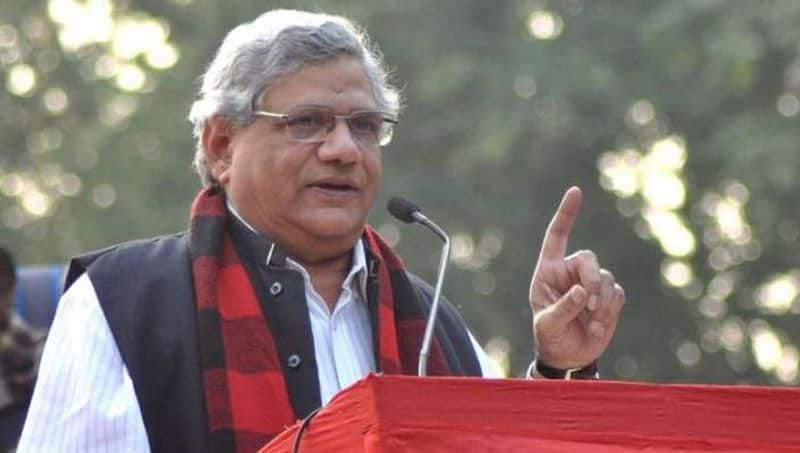Delivering a punchy speech, calling Prime Minister ‘pocketmar’ to rhyme with Narendra Modi’s self-proclaimed status of public’s ‘chowkidar’, Sitaram Yechury forgot the sins of his own party against peasants and landless labourers in West Bengal when the left lorded over the state for over three decades
The CPI(M), which fundamentally does not believe in democracy and is still struggling to wrap its head around the demise of its cherished worldview of a bipolar conflict between Capitalism and Marxism, led a rally of farmers to Delhi on Friday against the BJP-led Centre. It is the same peasantry they had reduced to utter and abject poverty while they raised slogans for the poor and marginalised today. The left maintained acute hunger and starvation in the process of the perpetuation of its power in West Bengal.
Delivering a punchy speech, calling the Prime Minister a ‘pocketmar’ to rhyme with Narendra Modi’s self-proclaimed status of public’s ‘chowkidar’, CPI(M) general secretary Sitaram Yechury forgot the sins of his own party against peasants and landless labourers in Bengal when the left lorded over the state for over three decades.
Economists Jean Drèze and Amartya Sen, who by no yardstick can be called rightwing sympathisers, have noted the prevalence of hunger deaths in Bengal during the left rule. Hunger killed thousands, they observed, in a legal and orderly fashion in the state. Hunger deaths were recorded not just from places like Amlasole in West Medinipur, but also from Kolkata.
Experts have cited the National Sample Survey (NSS) data from 2004-05 that reported that starvation in West Bengal was way higher than the national average. The state was more hungry in both the categories considered: families who went without two–square meals a day for the whole year and those which starved for only a few months every year.
While 1.7% of rural households in India went without enough food for some months a year, in rural Bengal close to 10% of households went without sufficient food for several months every year. Round the year inadequacy of food was again higher in West Bengal under the left rule than rest of India.
The NSS data that sapped the foundations of the left government’s pro-poor rhetoric in West Bengal was regarding the seasonality of hunger. A large number of rural families experienced starvation even during months of Kharif harvest. This meant the so-called land reform or other pro-poor programmes had been a dud, nay just slogans or gimmicks.
The NSS data in 2007 too followed the same trend, and Odisha was a distant second. Under the left government, rural Bengal saw a decline of rural poverty rather slower than the rest of the country.
And which part of the population was getting hungrier? Studies have shown that the wages of workers, agricultural and non-agricultural declined. Over the entire left rule in the state, the number of landless labourers increased manifold. This was the section which was facing starvation most.
So the twin processes of de-peasantisation and pauperisation of the agricultural workforce that plagued India as a result of British colonisation still remained active in West Bengal under the left rule.
To complement the above, the left rule also saw land grab by the party and the consequent farmer violence in Singur and Nandigram. The state saw armed bands of ‘harmad’ cadre or armada roaming rural Bengal and enforcing what is called ‘ekla dhokol’ or control of one, namely the party. Who did they harass? The small peasantry, landless labourers, marginal farmers and sharecroppers.
Those shedding crocodile’s tears for democracy under the Modi rule were the ones that unleashed upon voters in West Bengal what was called ‘jute bhoot’ or jute ghost. This ghost was a devout party cadre who used to stand behind the jute curtain covering the voting machine to see who was voting for the party and who was not. The oversight was important in the scheme of power preservation as cadre and voters were to be rewarded and dissenters to be punished by beatings and at times more.
How democratic was the practice of hemming a village pond and erecting the red flag on the boundary? Only party cadre and voters could draw water from it. Rest must walk the miles to drink if they were thirsty.
And the biggest friends of the poor also sat over India’s biggest genocide ever: Marichjhappi. By some estimates of this ill-reported event, the left government gunned down or forced to drown some 4200 families or almost 16000 people. And these were Namsudra Dalits.
Those who are standing with them — Congress and its various shades which include its mirror-image AAP — have conveniently set these contradictions of the left aside. Rightly so, no one is a friend or foe for long in politics, more so, when it is a question of survival.
Last Updated Nov 30, 2018, 6:05 PM IST











![Salman Khan sets stage on fire for Anant Ambani, Radhika Merchant pre-wedding festivities [WATCH] ATG](https://static-ai.asianetnews.com/images/01hr1hh8y86gvb4kbqgnyhc0w0/whatsapp-image-2024-03-03-at-12-24-37-pm_100x60xt.jpg)
![Pregnant Deepika Padukone dances with Ranveer Singh at Anant Ambani, Radhika Merchant pre-wedding bash [WATCH] ATG](https://static-ai.asianetnews.com/images/01hr1ffyd3nzqzgm6ba0k87vr8/whatsapp-image-2024-03-03-at-11-45-35-am_100x60xt.jpg)



